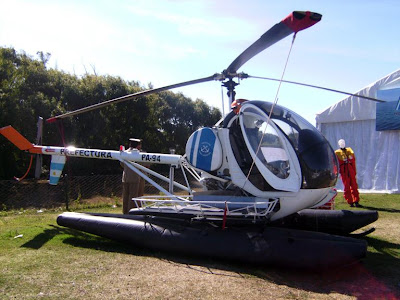On the Street 1264 Liniers of the locality of Tigre is located the Central Historical Museum Prefecture Naval Argentina (PNA) . Its nearly 400 m2 of surface are divided among 9 wards exhibiting coastguard and aircraft models, historic uniforms, small arms, nautical instruments, communications equipment, documents and lots of photos that testify to the importance of this force of history security.
Listed below is each of the rooms and a brief general reference material displayed.
1. Garden: In the front garden of the museum displays a service boat, a jet, a helicopter Hughes 360HS (PA-30) and wreckage from a stricken aircraft without identification.
2. Central Hall: barely enters the museum, a painting of the first Captain of Ports Dn. Martin James Thompson and a model of large Guard GC-12 "Spiro" Old school ship, welcome visitors.
3. Institutional History: This gallery exhibits primarily historical documentation on the origins of the PNA . An important one is also dedicated to honor industry members and media attended the institution during 1982 in Falklands War.
4. Iconography: In this small room through photographs shows the historical evolution of buildings and premises of the PNA , as well as of various terrestrial (cars and trucks) used throughout the years.
Photo 2. 1:110 scale diorama of Juan Bompland Detachment in 1937. Located along the coasts of Uruguay and Parana rivers these constructions of the PNA were typical of the 30's.
5. Services: This sector live various units of the PNA as Communications, Damage Control, Fire and Environmental Protection, and Rescue and Dive, through exposure to various elements such as: equipment radio, hoses, helmets and masks, and an old diving suit, and several photographs showing the development of these activities.
Photo 3. Sector Board Service exhibiting various radio and communications equipment.
Photo 4. Elements of Fire and Environmental Protection also shown in this room.
6. Weapons: In this room there are various firearms used by personal portable the PNA over its history: revolvers, pistols, rifles, rifles and machine guns and their ammunition. The exhibition also includes two Lee-Enfield rifles and a Bren gun captured the British Royal Marines landing after Malvinas of April 2, 1982 .
Photo 5. Sala de Armas where struck by the large number of guns on display.
Photo 6. Another sector of Arms Hall . In the cabinet on the wall left two Lee-Enfield rifles captured British in Malvinas . On the floor between the Browning machine gun of 7.62 mm with tripod and a heavy automatic rifle resting on a bipod FAP appears located the Bren gun English also captured on the islands.
7. Police: Here are exhibited different elements to perform tasks such as a suitcase expert instrumental in obtaining traces and images that portray a ballistics test. There are also several photographs recording various proceedings against drugs with major drug seizures.
8. Navigation and ports: great diversity of elements that make boating activity in this room live as Sprocket wheels, propellers, wind down, portholes, flares, rudder, sextant, compass. Also different graphics and murals that illustrate the visitor about the names of the ships and various marine knots, and photos of different ports and their evolution over time, where the PNA has a permanent presence.
9. Uniforms: S and Mannequins displayed in glass cases and the evolution of the uniform of the institution from its beginnings until today. Also swords, epaulets varying degrees, coats hats, clothing and various accessories. Notable for the unprecedented cork helmet covered in green cloth formerly used in subtropical areas.
Photo 7. Partial view of the Board of Rules . The center is occupied by a uniform historic Port Barge crew member and more current beige color for male and female staff.
10. Navigation: probably most interesting room of the museum . It will display models of naval and air yesterday and today, complete with photos and artwork that portray. The ship models has great detail, excellent finish and faithfully represent the means employed by the PNA .
Photo 8. In the Navigation Room be worn by the models, like the one on top of the patrol boat GC-64 "Mar del Plata" .
Other information of importance:
Views: Wednesday to Sunday from 10 to 12 and 14 to 18 hours.
Entry: free.
Phone: (011) 4749-6161 E-mail
: museohistoricopna@live.com.ar
Web: http://www.prefecturanaval.gov.ar/museo/index.html
The website of Museum is very well done, contains pictures and very interesting data, although the provision of photographed elements has changed from what is shown today.
recommend visit to the museum, you can go all the way in a calm and see everything in detail, and there are very diverse and interesting material. The day I attended I staff charge was not ideal, which corroborated with just a couple of questions asked, the only downside I found him to visit. Otherwise it is very well organized and very illustrative. I got plenty of photographic material that I will incorporate over future entries.










































